2015 BMW 335I XDRIVE SEDAN check engine
[x] Cancel search: check enginePage 225 of 257
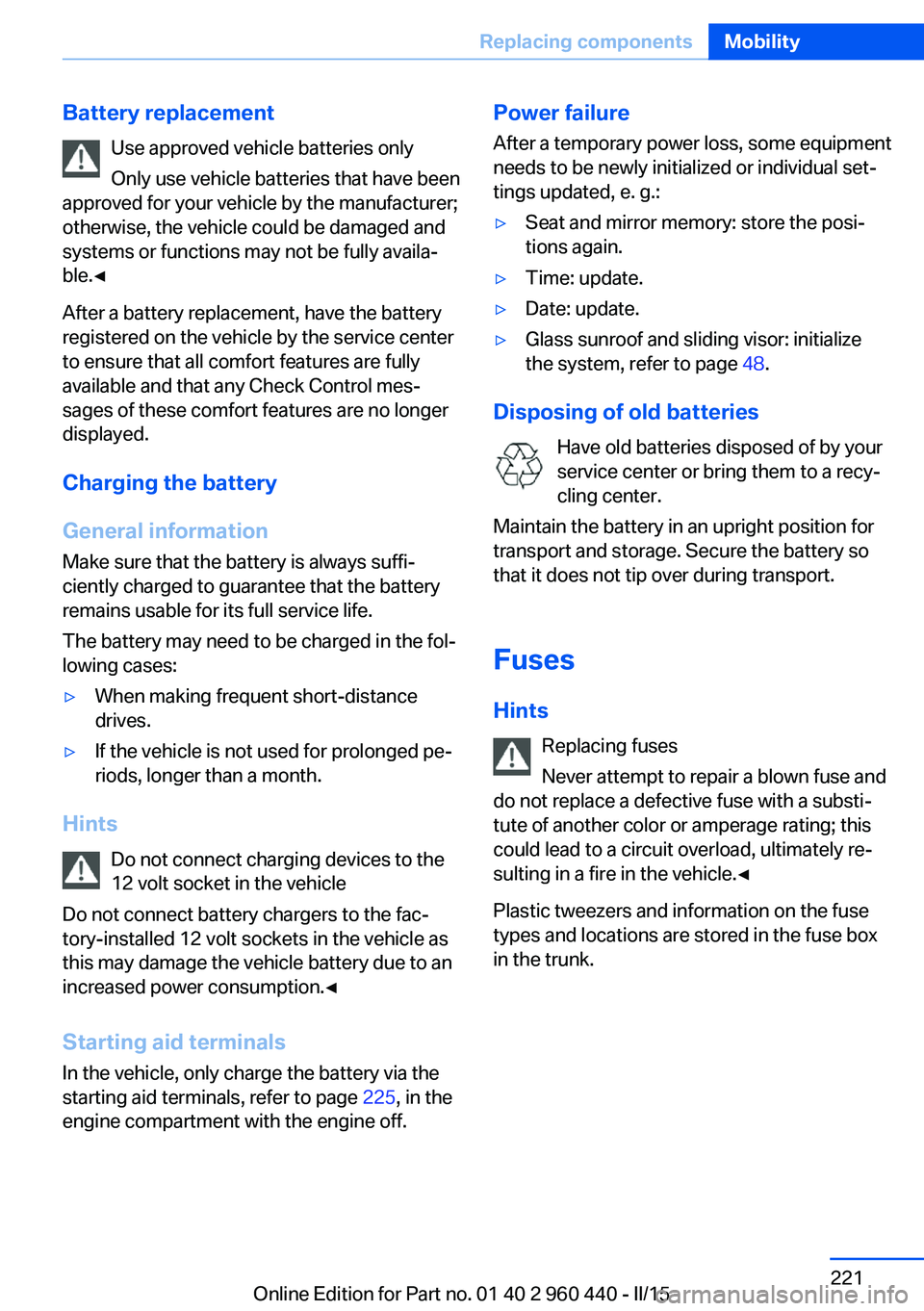
Battery replacementUse approved vehicle batteries only
Only use vehicle batteries that have been
approved for your vehicle by the manufacturer;
otherwise, the vehicle could be damaged and
systems or functions may not be fully availa‐
ble.◀
After a battery replacement, have the battery registered on the vehicle by the service center
to ensure that all comfort features are fully
available and that any Check Control mes‐
sages of these comfort features are no longer
displayed.
Charging the battery
General information Make sure that the battery is always suffi‐
ciently charged to guarantee that the battery
remains usable for its full service life.
The battery may need to be charged in the fol‐
lowing cases:▷When making frequent short-distance
drives.▷If the vehicle is not used for prolonged pe‐
riods, longer than a month.
Hints
Do not connect charging devices to the
12 volt socket in the vehicle
Do not connect battery chargers to the fac‐
tory-installed 12 volt sockets in the vehicle as
this may damage the vehicle battery due to an
increased power consumption.◀
Starting aid terminals
In the vehicle, only charge the battery via the
starting aid terminals, refer to page 225, in the
engine compartment with the engine off.
Power failure
After a temporary power loss, some equipment
needs to be newly initialized or individual set‐
tings updated, e. g.:▷Seat and mirror memory: store the posi‐
tions again.▷Time: update.▷Date: update.▷Glass sunroof and sliding visor: initialize
the system, refer to page 48.
Disposing of old batteries
Have old batteries disposed of by your
service center or bring them to a recy‐
cling center.
Maintain the battery in an upright position for
transport and storage. Secure the battery so
that it does not tip over during transport.
Fuses Hints Replacing fuses
Never attempt to repair a blown fuse and
do not replace a defective fuse with a substi‐
tute of another color or amperage rating; this
could lead to a circuit overload, ultimately re‐
sulting in a fire in the vehicle.◀
Plastic tweezers and information on the fuse
types and locations are stored in the fuse box
in the trunk.
Seite 221Replacing componentsMobility221
Online Edition for Part no. 01 40 2 960 440 - II/15
Page 228 of 257
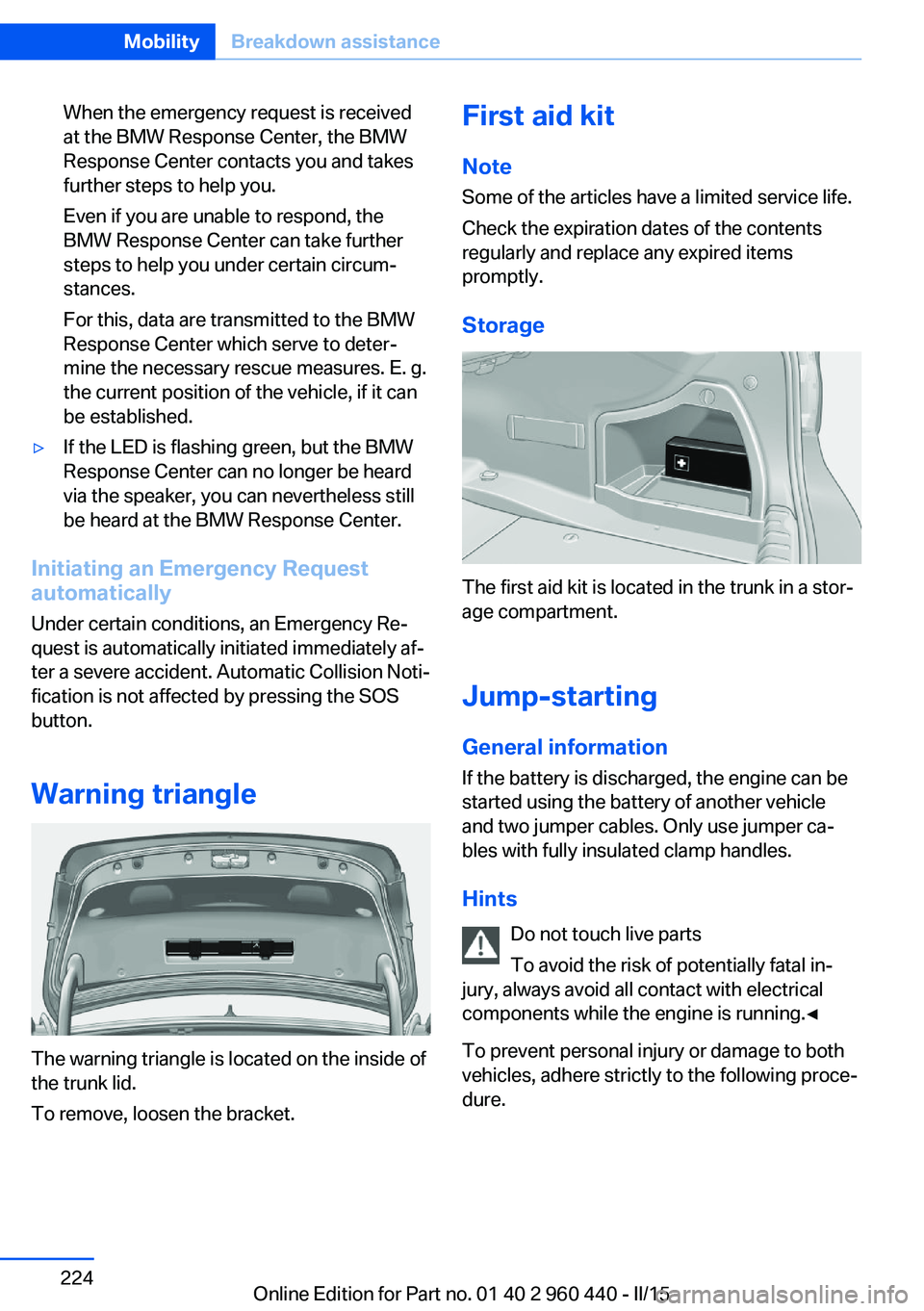
When the emergency request is received
at the BMW Response Center, the BMW
Response Center contacts you and takes
further steps to help you.
Even if you are unable to respond, the
BMW Response Center can take further
steps to help you under certain circum‐
stances.
For this, data are transmitted to the BMW
Response Center which serve to deter‐
mine the necessary rescue measures. E. g.
the current position of the vehicle, if it can
be established.▷If the LED is flashing green, but the BMW
Response Center can no longer be heard
via the speaker, you can nevertheless still
be heard at the BMW Response Center.
Initiating an Emergency Request
automatically
Under certain conditions, an Emergency Re‐
quest is automatically initiated immediately af‐
ter a severe accident. Automatic Collision Noti‐
fication is not affected by pressing the SOS
button.
Warning triangle
The warning triangle is located on the inside of
the trunk lid.
To remove, loosen the bracket.
First aid kit
Note
Some of the articles have a limited service life.
Check the expiration dates of the contents
regularly and replace any expired items
promptly.
Storage
The first aid kit is located in the trunk in a stor‐
age compartment.
Jump-starting General information
If the battery is discharged, the engine can be
started using the battery of another vehicle
and two jumper cables. Only use jumper ca‐
bles with fully insulated clamp handles.
Hints Do not touch live parts
To avoid the risk of potentially fatal in‐
jury, always avoid all contact with electrical
components while the engine is running.◀
To prevent personal injury or damage to both
vehicles, adhere strictly to the following proce‐
dure.
Seite 224MobilityBreakdown assistance224
Online Edition for Part no. 01 40 2 960 440 - II/15
Page 229 of 257
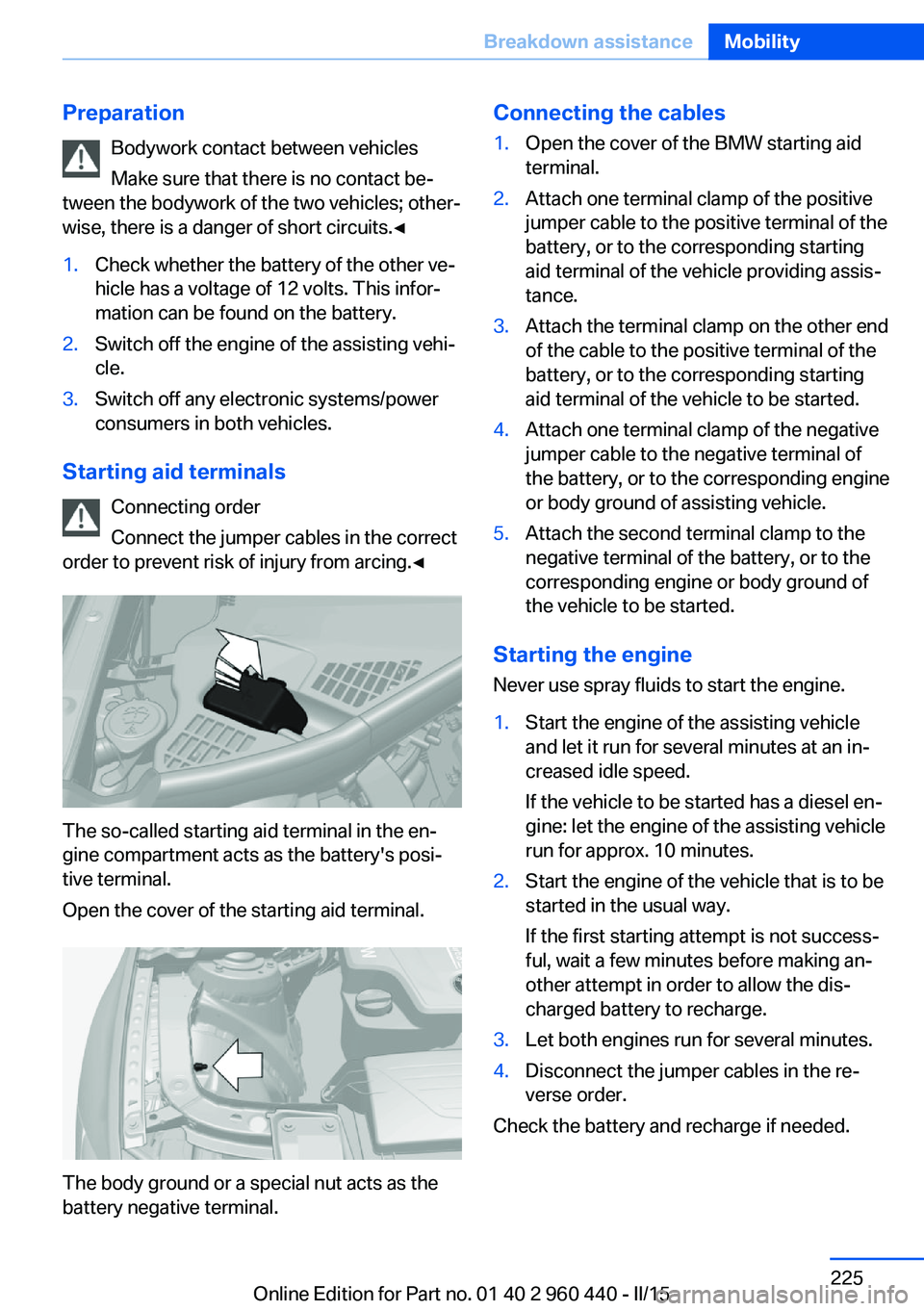
PreparationBodywork contact between vehicles
Make sure that there is no contact be‐
tween the bodywork of the two vehicles; other‐
wise, there is a danger of short circuits.◀1.Check whether the battery of the other ve‐
hicle has a voltage of 12 volts. This infor‐
mation can be found on the battery.2.Switch off the engine of the assisting vehi‐
cle.3.Switch off any electronic systems/power
consumers in both vehicles.
Starting aid terminals
Connecting order
Connect the jumper cables in the correct
order to prevent risk of injury from arcing.◀
The so-called starting aid terminal in the en‐
gine compartment acts as the battery's posi‐
tive terminal.
Open the cover of the starting aid terminal.
The body ground or a special nut acts as the
battery negative terminal.
Connecting the cables1.Open the cover of the BMW starting aid
terminal.2.Attach one terminal clamp of the positive
jumper cable to the positive terminal of the
battery, or to the corresponding starting
aid terminal of the vehicle providing assis‐
tance.3.Attach the terminal clamp on the other end
of the cable to the positive terminal of the
battery, or to the corresponding starting
aid terminal of the vehicle to be started.4.Attach one terminal clamp of the negative
jumper cable to the negative terminal of
the battery, or to the corresponding engine
or body ground of assisting vehicle.5.Attach the second terminal clamp to the
negative terminal of the battery, or to the
corresponding engine or body ground of
the vehicle to be started.
Starting the engine
Never use spray fluids to start the engine.
1.Start the engine of the assisting vehicle
and let it run for several minutes at an in‐
creased idle speed.
If the vehicle to be started has a diesel en‐
gine: let the engine of the assisting vehicle
run for approx. 10 minutes.2.Start the engine of the vehicle that is to be
started in the usual way.
If the first starting attempt is not success‐
ful, wait a few minutes before making an‐
other attempt in order to allow the dis‐
charged battery to recharge.3.Let both engines run for several minutes.4.Disconnect the jumper cables in the re‐
verse order.
Check the battery and recharge if needed.
Seite 225Breakdown assistanceMobility225
Online Edition for Part no. 01 40 2 960 440 - II/15
Page 232 of 257
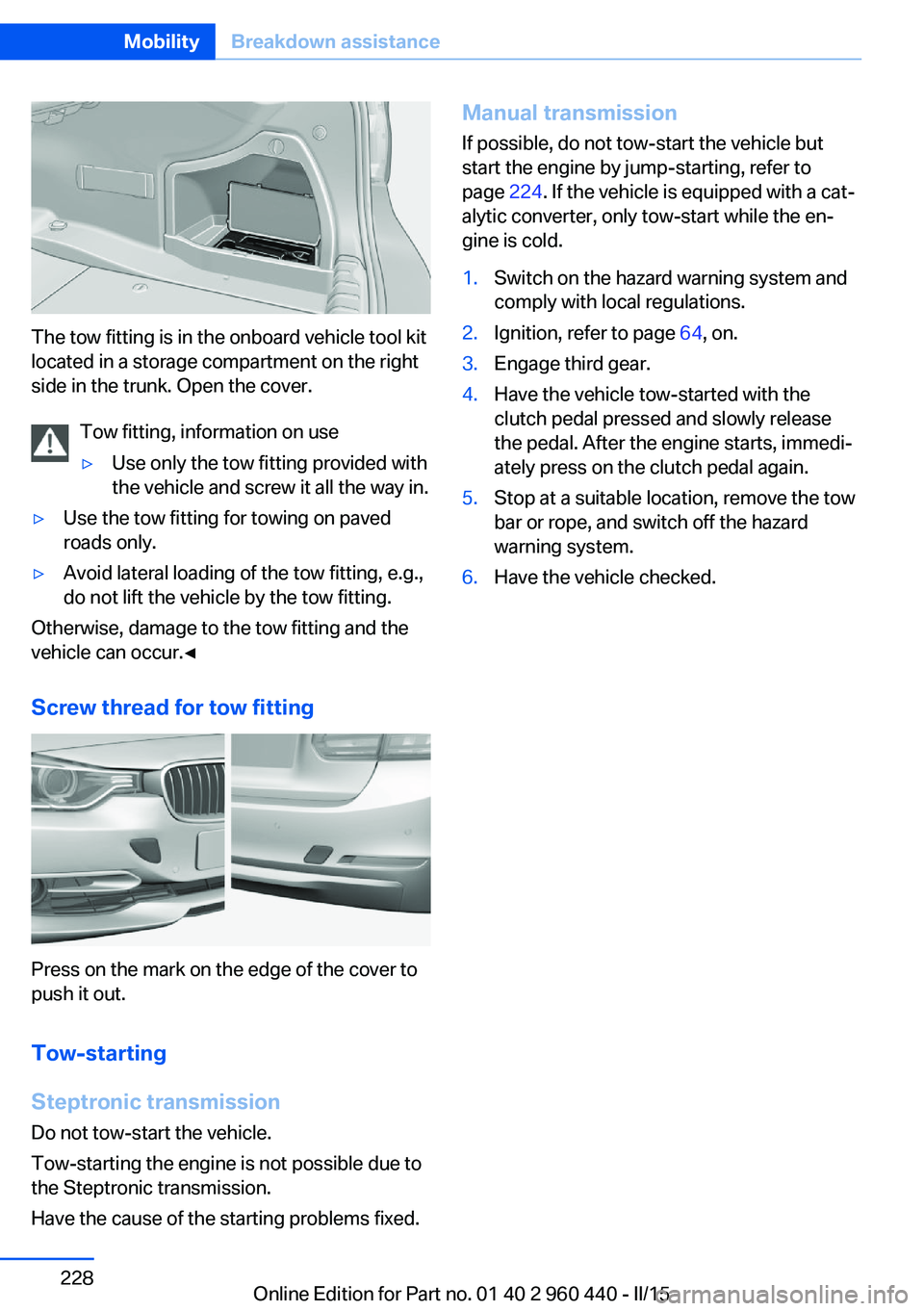
The tow fitting is in the onboard vehicle tool kit
located in a storage compartment on the right
side in the trunk. Open the cover.
Tow fitting, information on use
▷Use only the tow fitting provided with
the vehicle and screw it all the way in.▷Use the tow fitting for towing on paved
roads only.▷Avoid lateral loading of the tow fitting, e.g.,
do not lift the vehicle by the tow fitting.
Otherwise, damage to the tow fitting and the
vehicle can occur.◀
Screw thread for tow fitting
Press on the mark on the edge of the cover to
push it out.
Tow-starting
Steptronic transmission
Do not tow-start the vehicle.
Tow-starting the engine is not possible due to
the Steptronic transmission.
Have the cause of the starting problems fixed.
Manual transmission If possible, do not tow-start the vehicle but
start the engine by jump-starting, refer to
page 224. If the vehicle is equipped with a cat‐
alytic converter, only tow-start while the en‐
gine is cold.1.Switch on the hazard warning system and
comply with local regulations.2.Ignition, refer to page 64, on.3.Engage third gear.4.Have the vehicle tow-started with the
clutch pedal pressed and slowly release
the pedal. After the engine starts, immedi‐
ately press on the clutch pedal again.5.Stop at a suitable location, remove the tow
bar or rope, and switch off the hazard
warning system.6.Have the vehicle checked.Seite 228MobilityBreakdown assistance228
Online Edition for Part no. 01 40 2 960 440 - II/15
Page 234 of 257
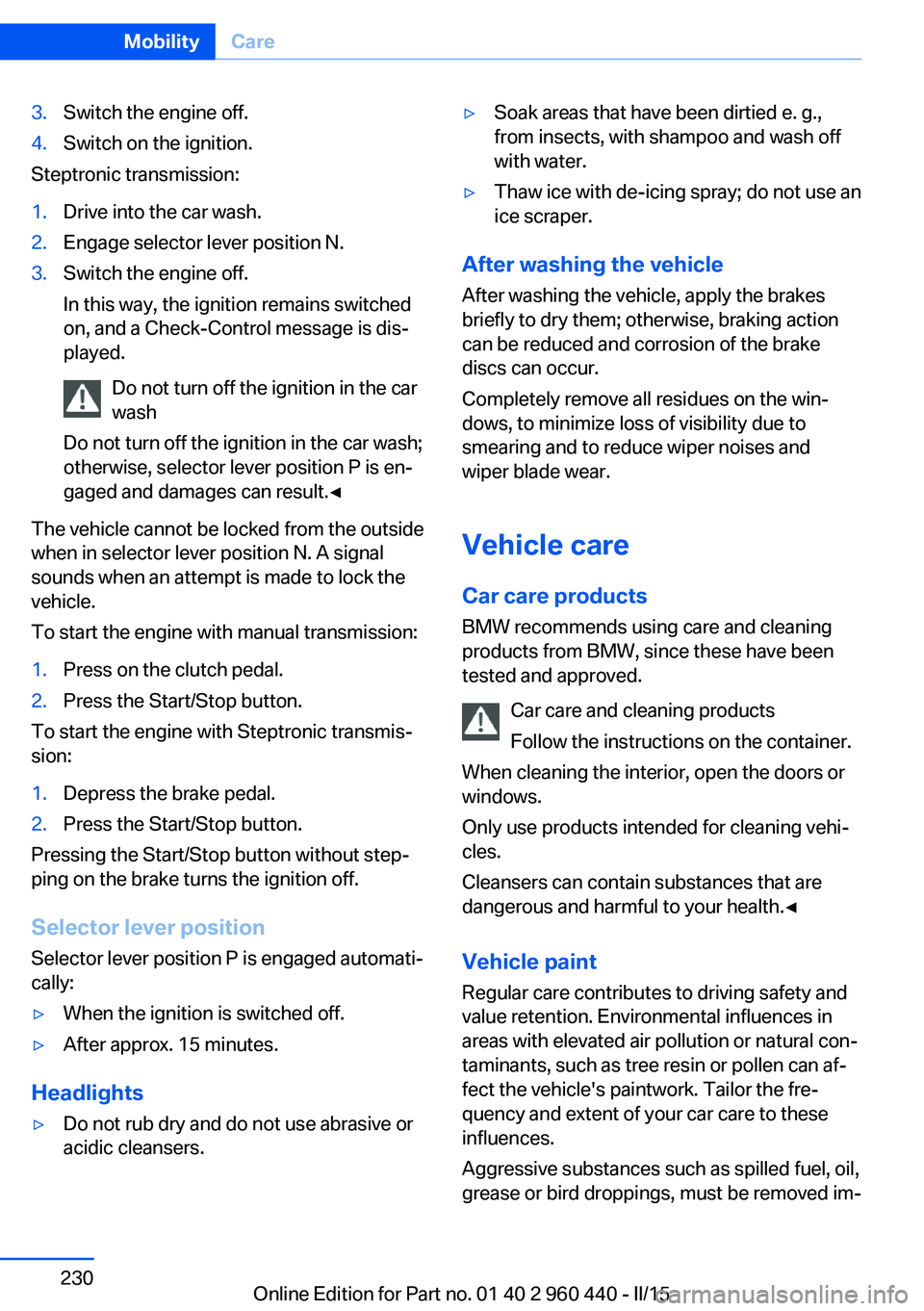
3.Switch the engine off.4.Switch on the ignition.
Steptronic transmission:
1.Drive into the car wash.2.Engage selector lever position N.3.Switch the engine off.
In this way, the ignition remains switched
on, and a Check-Control message is dis‐
played.
Do not turn off the ignition in the car
wash
Do not turn off the ignition in the car wash;
otherwise, selector lever position P is en‐
gaged and damages can result.◀
The vehicle cannot be locked from the outside
when in selector lever position N. A signal
sounds when an attempt is made to lock the
vehicle.
To start the engine with manual transmission:
1.Press on the clutch pedal.2.Press the Start/Stop button.
To start the engine with Steptronic transmis‐
sion:
1.Depress the brake pedal.2.Press the Start/Stop button.
Pressing the Start/Stop button without step‐
ping on the brake turns the ignition off.
Selector lever positionSelector lever position P is engaged automati‐
cally:
▷When the ignition is switched off.▷After approx. 15 minutes.
Headlights
▷Do not rub dry and do not use abrasive or
acidic cleansers.▷Soak areas that have been dirtied e. g.,
from insects, with shampoo and wash off
with water.▷Thaw ice with de-icing spray; do not use an
ice scraper.
After washing the vehicle
After washing the vehicle, apply the brakes
briefly to dry them; otherwise, braking action
can be reduced and corrosion of the brake
discs can occur.
Completely remove all residues on the win‐
dows, to minimize loss of visibility due to
smearing and to reduce wiper noises and
wiper blade wear.
Vehicle care
Car care products BMW recommends using care and cleaning
products from BMW, since these have been
tested and approved.
Car care and cleaning products
Follow the instructions on the container.
When cleaning the interior, open the doors or
windows.
Only use products intended for cleaning vehi‐
cles.
Cleansers can contain substances that are
dangerous and harmful to your health.◀
Vehicle paint
Regular care contributes to driving safety and
value retention. Environmental influences in
areas with elevated air pollution or natural con‐
taminants, such as tree resin or pollen can af‐
fect the vehicle's paintwork. Tailor the fre‐
quency and extent of your car care to these
influences.
Aggressive substances such as spilled fuel, oil,
grease or bird droppings, must be removed im‐
Seite 230MobilityCare230
Online Edition for Part no. 01 40 2 960 440 - II/15
Page 247 of 257
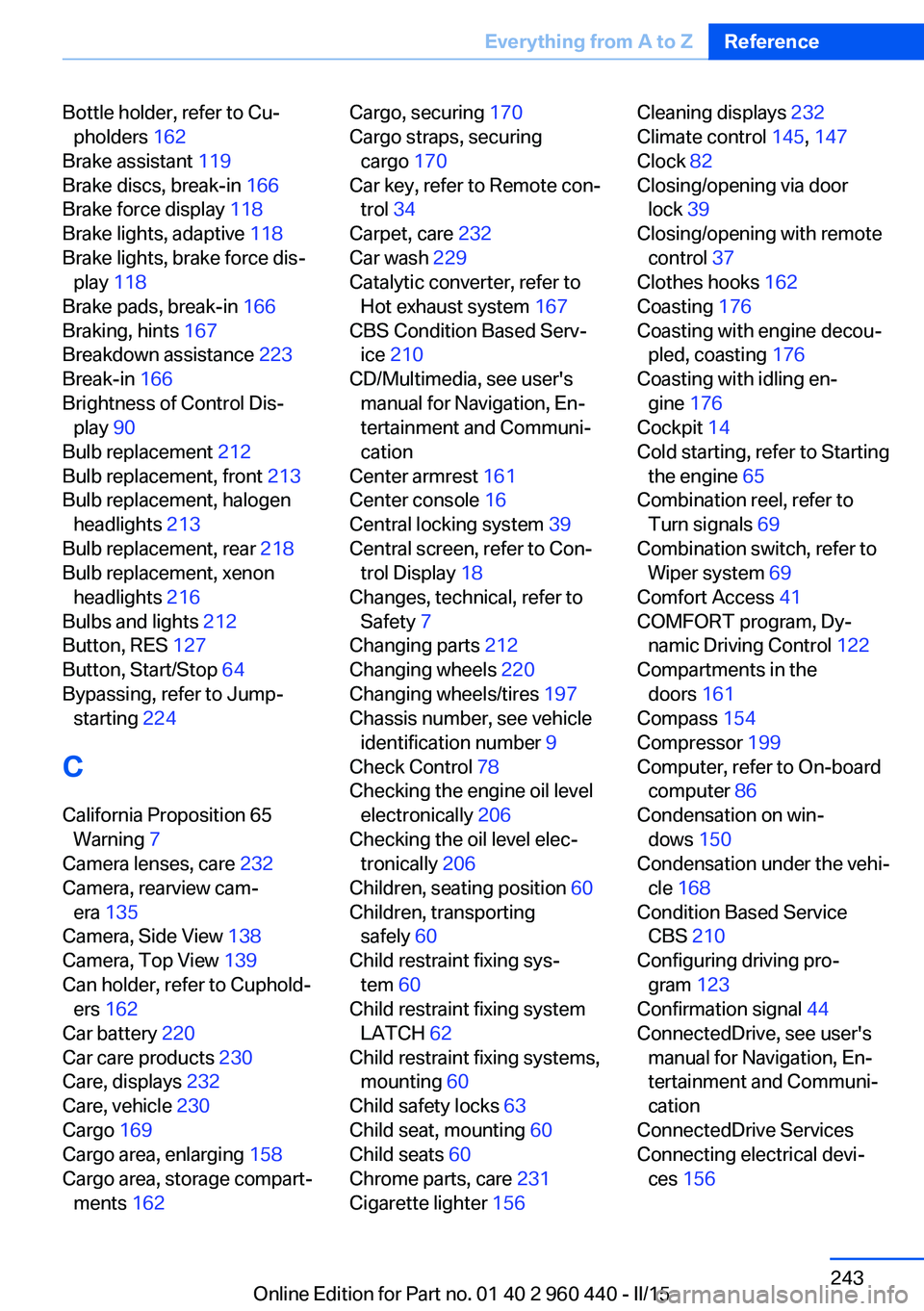
Bottle holder, refer to Cu‐pholders 162
Brake assistant 119
Brake discs, break-in 166
Brake force display 118
Brake lights, adaptive 118
Brake lights, brake force dis‐ play 118
Brake pads, break-in 166
Braking, hints 167
Breakdown assistance 223
Break-in 166
Brightness of Control Dis‐ play 90
Bulb replacement 212
Bulb replacement, front 213
Bulb replacement, halogen headlights 213
Bulb replacement, rear 218
Bulb replacement, xenon headlights 216
Bulbs and lights 212
Button, RES 127
Button, Start/Stop 64
Bypassing, refer to Jump- starting 224
C
California Proposition 65 Warning 7
Camera lenses, care 232
Camera, rearview cam‐ era 135
Camera, Side View 138
Camera, Top View 139
Can holder, refer to Cuphold‐ ers 162
Car battery 220
Car care products 230
Care, displays 232
Care, vehicle 230
Cargo 169
Cargo area, enlarging 158
Cargo area, storage compart‐ ments 162 Cargo, securing 170
Cargo straps, securing cargo 170
Car key, refer to Remote con‐ trol 34
Carpet, care 232
Car wash 229
Catalytic converter, refer to Hot exhaust system 167
CBS Condition Based Serv‐ ice 210
CD/Multimedia, see user's manual for Navigation, En‐
tertainment and Communi‐
cation
Center armrest 161
Center console 16
Central locking system 39
Central screen, refer to Con‐ trol Display 18
Changes, technical, refer to Safety 7
Changing parts 212
Changing wheels 220
Changing wheels/tires 197
Chassis number, see vehicle identification number 9
Check Control 78
Checking the engine oil level electronically 206
Checking the oil level elec‐ tronically 206
Children, seating position 60
Children, transporting safely 60
Child restraint fixing sys‐ tem 60
Child restraint fixing system LATCH 62
Child restraint fixing systems, mounting 60
Child safety locks 63
Child seat, mounting 60
Child seats 60
Chrome parts, care 231
Cigarette lighter 156 Cleaning displays 232
Climate control 145, 147
Clock 82
Closing/opening via door lock 39
Closing/opening with remote control 37
Clothes hooks 162
Coasting 176
Coasting with engine decou‐ pled, coasting 176
Coasting with idling en‐ gine 176
Cockpit 14
Cold starting, refer to Starting the engine 65
Combination reel, refer to Turn signals 69
Combination switch, refer to Wiper system 69
Comfort Access 41
COMFORT program, Dy‐ namic Driving Control 122
Compartments in the doors 161
Compass 154
Compressor 199
Computer, refer to On-board computer 86
Condensation on win‐ dows 150
Condensation under the vehi‐ cle 168
Condition Based Service CBS 210
Configuring driving pro‐ gram 123
Confirmation signal 44
ConnectedDrive, see user's manual for Navigation, En‐
tertainment and Communi‐
cation
ConnectedDrive Services
Connecting electrical devi‐ ces 156 Seite 243Everything from A to ZReference243
Online Edition for Part no. 01 40 2 960 440 - II/15
Page 249 of 257
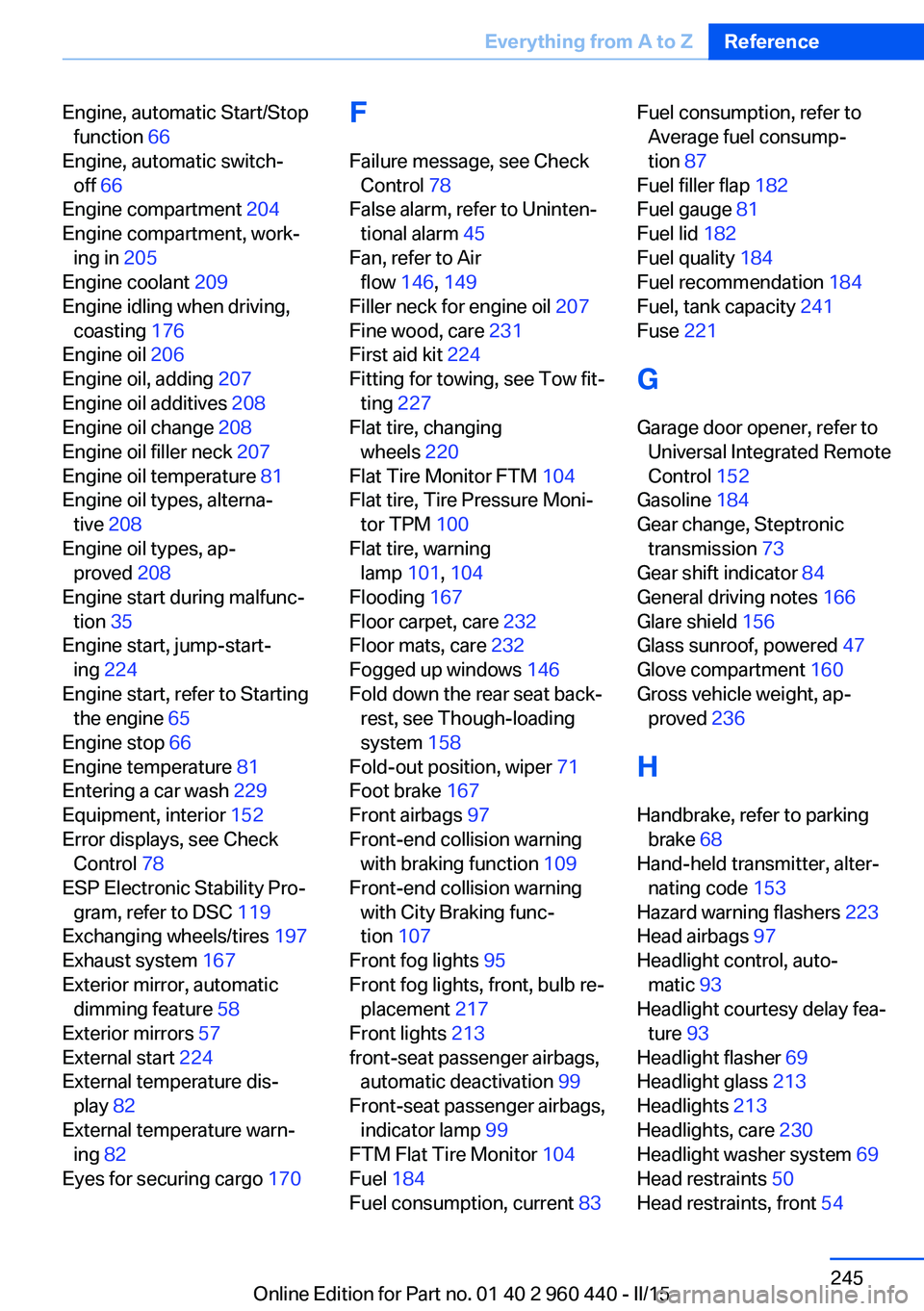
Engine, automatic Start/Stopfunction 66
Engine, automatic switch- off 66
Engine compartment 204
Engine compartment, work‐ ing in 205
Engine coolant 209
Engine idling when driving, coasting 176
Engine oil 206
Engine oil, adding 207
Engine oil additives 208
Engine oil change 208
Engine oil filler neck 207
Engine oil temperature 81
Engine oil types, alterna‐ tive 208
Engine oil types, ap‐ proved 208
Engine start during malfunc‐ tion 35
Engine start, jump-start‐ ing 224
Engine start, refer to Starting the engine 65
Engine stop 66
Engine temperature 81
Entering a car wash 229
Equipment, interior 152
Error displays, see Check Control 78
ESP Electronic Stability Pro‐ gram, refer to DSC 119
Exchanging wheels/tires 197
Exhaust system 167
Exterior mirror, automatic dimming feature 58
Exterior mirrors 57
External start 224
External temperature dis‐ play 82
External temperature warn‐ ing 82
Eyes for securing cargo 170 F
Failure message, see Check Control 78
False alarm, refer to Uninten‐ tional alarm 45
Fan, refer to Air flow 146, 149
Filler neck for engine oil 207
Fine wood, care 231
First aid kit 224
Fitting for towing, see Tow fit‐ ting 227
Flat tire, changing wheels 220
Flat Tire Monitor FTM 104
Flat tire, Tire Pressure Moni‐ tor TPM 100
Flat tire, warning lamp 101, 104
Flooding 167
Floor carpet, care 232
Floor mats, care 232
Fogged up windows 146
Fold down the rear seat back‐ rest, see Though-loading
system 158
Fold-out position, wiper 71
Foot brake 167
Front airbags 97
Front-end collision warning with braking function 109
Front-end collision warning with City Braking func‐
tion 107
Front fog lights 95
Front fog lights, front, bulb re‐ placement 217
Front lights 213
front-seat passenger airbags, automatic deactivation 99
Front-seat passenger airbags, indicator lamp 99
FTM Flat Tire Monitor 104
Fuel 184
Fuel consumption, current 83 Fuel consumption, refer to
Average fuel consump‐
tion 87
Fuel filler flap 182
Fuel gauge 81
Fuel lid 182
Fuel quality 184
Fuel recommendation 184
Fuel, tank capacity 241
Fuse 221
G Garage door opener, refer to Universal Integrated Remote
Control 152
Gasoline 184
Gear change, Steptronic transmission 73
Gear shift indicator 84
General driving notes 166
Glare shield 156
Glass sunroof, powered 47
Glove compartment 160
Gross vehicle weight, ap‐ proved 236
H Handbrake, refer to parking brake 68
Hand-held transmitter, alter‐ nating code 153
Hazard warning flashers 223
Head airbags 97
Headlight control, auto‐ matic 93
Headlight courtesy delay fea‐ ture 93
Headlight flasher 69
Headlight glass 213
Headlights 213
Headlights, care 230
Headlight washer system 69
Head restraints 50
Head restraints, front 54 Seite 245Everything from A to ZReference245
Online Edition for Part no. 01 40 2 960 440 - II/15
Page 254 of 257
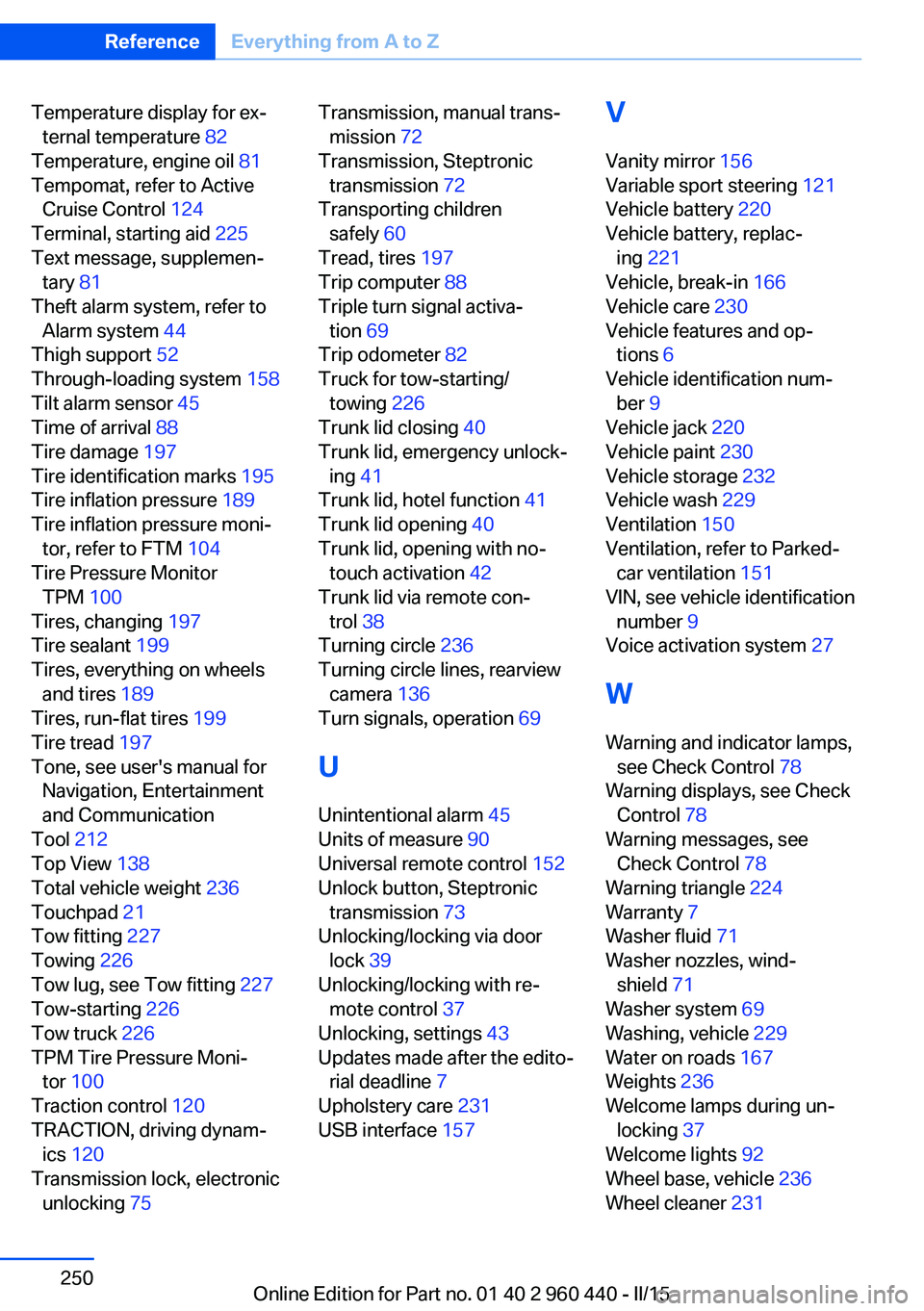
Temperature display for ex‐ternal temperature 82
Temperature, engine oil 81
Tempomat, refer to Active Cruise Control 124
Terminal, starting aid 225
Text message, supplemen‐ tary 81
Theft alarm system, refer to Alarm system 44
Thigh support 52
Through-loading system 158
Tilt alarm sensor 45
Time of arrival 88
Tire damage 197
Tire identification marks 195
Tire inflation pressure 189
Tire inflation pressure moni‐ tor, refer to FTM 104
Tire Pressure Monitor TPM 100
Tires, changing 197
Tire sealant 199
Tires, everything on wheels and tires 189
Tires, run-flat tires 199
Tire tread 197
Tone, see user's manual for Navigation, Entertainment
and Communication
Tool 212
Top View 138
Total vehicle weight 236
Touchpad 21
Tow fitting 227
Towing 226
Tow lug, see Tow fitting 227
Tow-starting 226
Tow truck 226
TPM Tire Pressure Moni‐ tor 100
Traction control 120
TRACTION, driving dynam‐ ics 120
Transmission lock, electronic unlocking 75 Transmission, manual trans‐
mission 72
Transmission, Steptronic transmission 72
Transporting children safely 60
Tread, tires 197
Trip computer 88
Triple turn signal activa‐ tion 69
Trip odometer 82
Truck for tow-starting/ towing 226
Trunk lid closing 40
Trunk lid, emergency unlock‐ ing 41
Trunk lid, hotel function 41
Trunk lid opening 40
Trunk lid, opening with no- touch activation 42
Trunk lid via remote con‐ trol 38
Turning circle 236
Turning circle lines, rearview camera 136
Turn signals, operation 69
U Unintentional alarm 45
Units of measure 90
Universal remote control 152
Unlock button, Steptronic transmission 73
Unlocking/locking via door lock 39
Unlocking/locking with re‐ mote control 37
Unlocking, settings 43
Updates made after the edito‐ rial deadline 7
Upholstery care 231
USB interface 157 V
Vanity mirror 156
Variable sport steering 121
Vehicle battery 220
Vehicle battery, replac‐ ing 221
Vehicle, break-in 166
Vehicle care 230
Vehicle features and op‐ tions 6
Vehicle identification num‐ ber 9
Vehicle jack 220
Vehicle paint 230
Vehicle storage 232
Vehicle wash 229
Ventilation 150
Ventilation, refer to Parked- car ventilation 151
VIN, see vehicle identification number 9
Voice activation system 27
W Warning and indicator lamps, see Check Control 78
Warning displays, see Check Control 78
Warning messages, see Check Control 78
Warning triangle 224
Warranty 7
Washer fluid 71
Washer nozzles, wind‐ shield 71
Washer system 69
Washing, vehicle 229
Water on roads 167
Weights 236
Welcome lamps during un‐ locking 37
Welcome lights 92
Wheel base, vehicle 236
Wheel cleaner 231 Seite 250ReferenceEverything from A to Z250
Online Edition for Part no. 01 40 2 960 440 - II/15